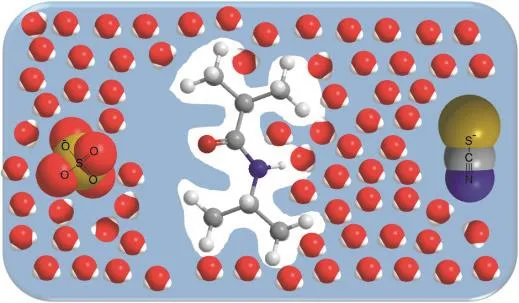How Hofmeister Ions Change the Local Environment around Thermoresponsive Polymers in Aqueous Solutions: an NMR Study
2019-01-23XUEZhiminYANChuanyuZHAOXinhuiYUDongkunMUTiancheng
XUE Zhimin YAN Chuanyu , ZHAO Xinhui , YU Dongkun , MU Tiancheng ,*
1 Beijing Key Laboratory of Lignocellulosic Chemistry, College of Materials Science and Technology, Beijing Forestry University,Beijing 100083, P. R. China.
2 Department of Chemistry, Renmin University of China, Beijing 100872, P. R. China.
Abstract: The Hofmeister ion effect is a very interesting but elusive phenomenon, the importance of which is revealed in self-assembly, ion recognition, and protein folding regulation. With an increasing number of studies suggesting that interactions between ions and solutes play a role in the Hofmeister ion effect, the nature of the Hofmeister phenomenon becomes more debatable. Yet, it is not clear whether the Hofmeister ion effect is a local effect or bulk effect that can reach beyond many hydration shells, where specific interactions between ions and solutes play key roles.In order to further explore this, we applied proton nuclear magnetic resonance (1H-NMR) spectroscopy to study the effects of specific ions on the local environment around N,N-dimethylpropionamide (NDA) and N-isopropylisobutyramide (NPA), which are the model compounds for poly(2-ethyl-2-oxazoline) and poly(N-isopropylacrylamide), respectively. These polymers are important bio-engineering materials that possess thermoresponsive properties and are also subject to specific ion effects. By correlating the changes in chemical shifts of the two methyl groups on either side of the amide bond, it was found that the Hofmeister ion effects on NPA were more anisotropic than on NDA, and that the cationic effects were more anisotropic than the anionic effects on NPA. These results indicated that the effects of specific ions were almost identical for all methyl groups of NDA.On the other hand, NPA is a larger molecule; thus, not all of its methyl groups were subjected to the specific ion effects to the same extent. The calculation of the electrostatic potential surfaces of NDA and NPA suggested that these observations on the Hofmeister ion effects might be due to steric hindrance, and that the observations on the cationic effects might be due to the interactions between cations and NPA being stronger than the interactions between anions and NPA. This would explain why the highly charged cations caused a significant anisotropicity. Additionally, we found that the chemical shift of the water protons (ΔδH2O) of conventional kosmotropic anions was larger than zero, which suggested a stronger HB and more charge transfer between water and these anions. The ΔδH2O of conventional chaotropic anions was less than zero. Despite the different solutes, the results were indifferent in both NDA and NPA solutions. Surprisingly, the ΔδH2O of Cl- at concentrations lower than 1 mol·L-1 was zero, thus becoming the benchmark between chaotropes and kosmotropes. These results suggested a quantitative measurement of kosmotropicity/chaotropicity, where the anion would be kosmotropic if its ΔδH2O were higher than that of Cl- and chaotropic for the opposing condition. Moreover, the results showed that the effects of the cations on the water structure were minimal, which was consistent with minimal charge transfer between the cations and water. The overall results of this study suggest that the Hofmeister ion effect is a global effect, while local interactions of ions with solutes also play a key role.
Key Words: Thermoresponsive polymer; Amide; Hofmeister effects; Ions; NMR

